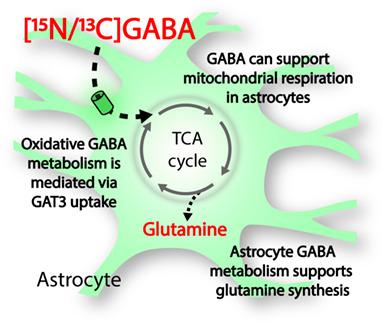Our official English website, www.x-mol.net, welcomes your feedback! (Note: you will need to create a separate account there.)
Extensive astrocyte metabolism of γ-aminobutyric acid (GABA) sustains glutamine synthesis in the mammalian cerebral cortex.
Glia ( IF 6.2 ) Pub Date : 2020-06-25 , DOI: 10.1002/glia.23872 Jens V Andersen 1 , Emil Jakobsen 1 , Emil W Westi 1 , Maria E K Lie 1 , Caroline M Voss 1 , Blanca I Aldana 1 , Arne Schousboe 1 , Petrine Wellendorph 1 , Lasse K Bak 1 , Lars H Pinborg 2 , Helle S Waagepetersen 1
Glia ( IF 6.2 ) Pub Date : 2020-06-25 , DOI: 10.1002/glia.23872 Jens V Andersen 1 , Emil Jakobsen 1 , Emil W Westi 1 , Maria E K Lie 1 , Caroline M Voss 1 , Blanca I Aldana 1 , Arne Schousboe 1 , Petrine Wellendorph 1 , Lasse K Bak 1 , Lars H Pinborg 2 , Helle S Waagepetersen 1
Affiliation

|
Synaptic transmission is closely linked to brain energy and neurotransmitter metabolism. However, the extent of brain metabolism of the inhibitory neurotransmitter γ‐aminobutyric acid (GABA), and the relative metabolic contributions of neurons and astrocytes, are yet unknown. The present study was designed to investigate the functional significance of brain GABA metabolism using isolated mouse cerebral cortical slices and slices of neurosurgically resected neocortical human tissue of the temporal lobe. By using dynamic isotope labeling, with [15N]GABA and [U‐13C]GABA as metabolic substrates, we show that both mouse and human brain slices exhibit a large capacity for GABA metabolism. Both the nitrogen and the carbon backbone of GABA strongly support glutamine synthesis, particularly in the human cerebral cortex, indicative of active astrocytic GABA metabolism. This was further substantiated by pharmacological inhibition of the primary astrocytic GABA transporter subtype 3 (GAT3), by (S)‐SNAP‐5114 or 1‐benzyl‐5‐chloro‐2,3‐dihydro‐1H‐indole‐2,3‐dione (compound 34), leading to significant reductions in oxidative GABA carbon metabolism. Interestingly, this was not the case when tiagabine was used to specifically inhibit GAT1, which is predominantly found on neurons. Finally, we show that acute GABA exposure does not directly stimulate glycolytic activity nor oxidative metabolism in cultured astrocytes, but can be used as an additional substrate to enhance uncoupled respiration. These results clearly show that GABA is actively metabolized in astrocytes, particularly for the synthesis of glutamine, and challenge the current view that synaptic GABA homeostasis is maintained primarily by presynaptic recycling.
中文翻译:

γ-氨基丁酸 (GABA) 的广泛星形胶质细胞代谢维持哺乳动物大脑皮层中的谷氨酰胺合成。
突触传递与脑能量和神经递质代谢密切相关。然而,抑制性神经递质γ-氨基丁酸(GABA)的脑代谢程度以及神经元和星形胶质细胞的相对代谢贡献尚不清楚。本研究旨在使用离体的小鼠大脑皮层切片和神经外科切除的颞叶新皮层人体组织切片来研究大脑 GABA 代谢的功能意义。通过使用动态同位素标记,[ 15 N]GABA 和 [U- 13C]GABA 作为代谢底物,我们表明小鼠和人脑切片都表现出很大的 GABA 代谢能力。GABA 的氮和碳骨架都强烈支持谷氨酰胺合成,特别是在人类大脑皮层中,表明星形胶质细胞 GABA 代谢活跃。这进一步被初级星形胶质细胞 GABA 转运蛋白 3 亚型 (GAT3) 的药理学抑制所证实,由 ( S)-SNAP-5114 或 1-benzyl-5-chloro-2,3-dihydro-1H-indole-2,3-dione(化合物 34),导致氧化 GABA 碳代谢显着减少。有趣的是,当 tiagabine 用于特异性抑制 GAT1 时,情况并非如此,GAT1 主要存在于神经元上。最后,我们表明急性 GABA 暴露不会直接刺激培养的星形胶质细胞中的糖酵解活性或氧化代谢,但可以用作增强非耦合呼吸的额外底物。这些结果清楚地表明 GABA 在星形胶质细胞中被积极代谢,特别是对于谷氨酰胺的合成,并挑战了当前认为突触 GABA 稳态主要通过突触前循环维持的观点。
更新日期:2020-06-25
中文翻译:

γ-氨基丁酸 (GABA) 的广泛星形胶质细胞代谢维持哺乳动物大脑皮层中的谷氨酰胺合成。
突触传递与脑能量和神经递质代谢密切相关。然而,抑制性神经递质γ-氨基丁酸(GABA)的脑代谢程度以及神经元和星形胶质细胞的相对代谢贡献尚不清楚。本研究旨在使用离体的小鼠大脑皮层切片和神经外科切除的颞叶新皮层人体组织切片来研究大脑 GABA 代谢的功能意义。通过使用动态同位素标记,[ 15 N]GABA 和 [U- 13C]GABA 作为代谢底物,我们表明小鼠和人脑切片都表现出很大的 GABA 代谢能力。GABA 的氮和碳骨架都强烈支持谷氨酰胺合成,特别是在人类大脑皮层中,表明星形胶质细胞 GABA 代谢活跃。这进一步被初级星形胶质细胞 GABA 转运蛋白 3 亚型 (GAT3) 的药理学抑制所证实,由 ( S)-SNAP-5114 或 1-benzyl-5-chloro-2,3-dihydro-1H-indole-2,3-dione(化合物 34),导致氧化 GABA 碳代谢显着减少。有趣的是,当 tiagabine 用于特异性抑制 GAT1 时,情况并非如此,GAT1 主要存在于神经元上。最后,我们表明急性 GABA 暴露不会直接刺激培养的星形胶质细胞中的糖酵解活性或氧化代谢,但可以用作增强非耦合呼吸的额外底物。这些结果清楚地表明 GABA 在星形胶质细胞中被积极代谢,特别是对于谷氨酰胺的合成,并挑战了当前认为突触 GABA 稳态主要通过突触前循环维持的观点。


























 京公网安备 11010802027423号
京公网安备 11010802027423号